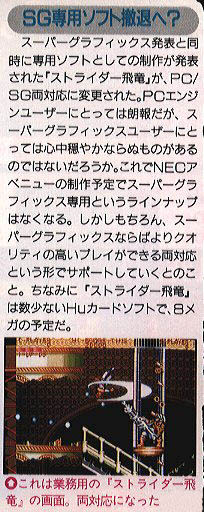The Rumored SuperGrafx Conversion
Of all the Strider home conversions, the one for the NEC SuperGrafx has been the subject of the most debate. Which is odd, because it was never actually released. Lots of theories about why it never saw the light of day have been advanced over the years, but when exposed to the light of day themselves, these theories amount to little more than rumor and urban legend.
That's really all there is to it. If you want hard facts and the final word on what happened to the SGX conversion, you're going to be disappointed. The only people who know anything for sure aren't talking, and without their accounts, all the evidence is inconclusive.
If, on the other hand, you like urban legends and are comfortable with interpreting circumstantial evidence, do I ever have a story for you.
Pull up a chair and get comfortable. This one's going to take a while.
In 1989, Capcom ruled the arcades. Their CPS-1 games (e.g. Forgotten Worlds, Ghouls N' Ghosts, and Strider) were their calling cards and were very nearly licenses to print money. Strider in particular was a huge draw, due to its large, colorful sprites, thrilling gameplay mechanics, and voice samples that made it seem like a playable Saturday morning cartoon. Naturally, Capcom licensed their CPS-1 games to the home consoles of the time, and the Genesis port of Strider heavily contributed to that console's early success.
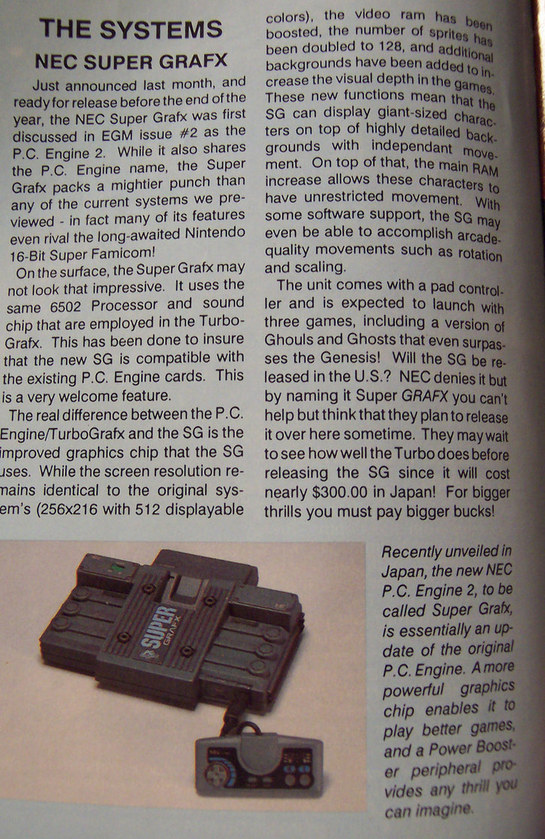 But all was not well. Nintendo was unhappy because Capcom had made their competitor's more powerful system a success, but that's a story for another time. More importantly, NEC was also unhappy. NEC's PC-Engine/TurboGrafx was struggling to take off in America, due to two things: Nintendo's virtual monopoly on third-party developers, and a large part of NEC's Japanese game library consisting of RPG's. Bringing these games to America would mean translating hundreds, if not thousands, of hours of RPG dialog.
But all was not well. Nintendo was unhappy because Capcom had made their competitor's more powerful system a success, but that's a story for another time. More importantly, NEC was also unhappy. NEC's PC-Engine/TurboGrafx was struggling to take off in America, due to two things: Nintendo's virtual monopoly on third-party developers, and a large part of NEC's Japanese game library consisting of RPG's. Bringing these games to America would mean translating hundreds, if not thousands, of hours of RPG dialog.
Instead of doing that, NEC developed a new system, the PC-Engine 2/SuperGrafx. Since Capcom was the third-party developer most successful at sticking it to Nintendo, NEC bought licenses to port Capcom's games to their new system, perhaps hoping the same thing would happen to them that happened to Sega.
This is crucial. NEC licensed the Capcom titles and developed them in-house through NEC Avenue. Keep this in mind.
In late 1990, NEC announced its new system and the slate it had lined up for the first, and as it turned out, only generation of SGX games. One of these was, naturally, Strider. NEC made some pretty hefty claims concerning its upcoming port, which the Japanese gaming magazine PC Engine Fan reported in its September issue of that year (Japanese text transcribed by Chris Covell; translated by Suzaku, LSCM senior staff):
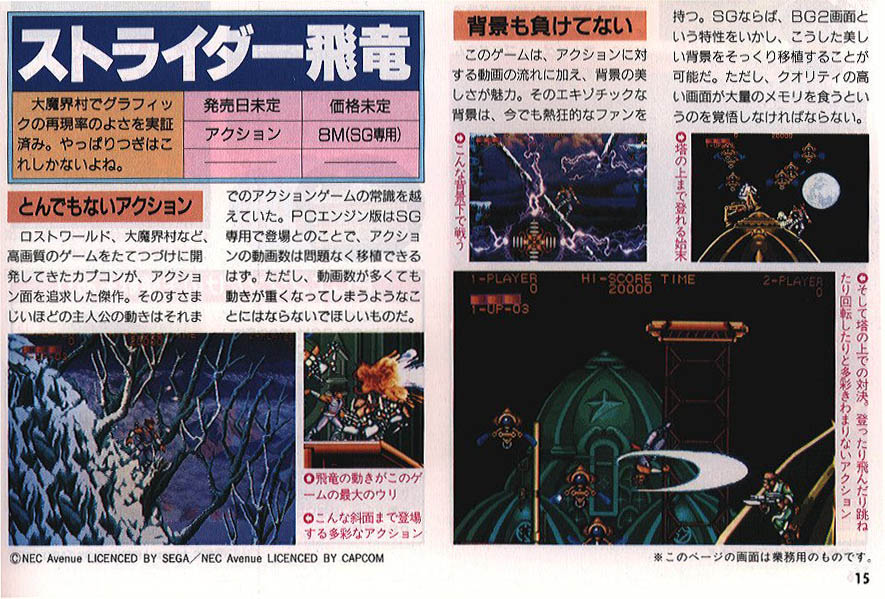
Ghouls 'n Ghosts proved that the reproduction of high quality graphics was possible. This is obviously the next logical step. On Sale: tentative Price: tentative Action 8M (only for SG) Unexpected Action Forgotten Worlds, Ghouls 'n Ghosts... Capcom just keeps developing high-resolution games in their pursuit of side-scrolling action masterpieces. This hero's ferocious animations are well beyond anything we've seen in action games so far. This SG exclusive is scheduled to appear alongside the PC Engine version, and they should be able to port the numerous action animations without any problems. However, with that vast amount of animations, we can only hope that it doesn't cause slow-down. ↑ Hiryu's movement is the game's biggest selling point. ← All sorts of action appears, like this slope. Undefeated Backgrounds In addition to the action with its flowing animations, the game has beautiful backgrounds that add to the charm. The exotic backgrounds still have enthusiastic fans. With the SG, it's possible to completely port these beautiful backgrounds using the special characteristics of the BG2 layer. However, it remains to be seen if the high quality visuals will take a big bite out of the memory. → He does battle beneath backgrounds like this. → He managed to climb to the top of the pagoda. ← And now fights on the towers. With climbing, jumping, soaring, and flipping, there's a wide variety of actions to take. * The screenshots on this page are from the arcade version. |
大魔界村でグラフィックの再現率のよさを実証済み。やっぱりつぎはこれしかないよね。 発売日未定 価格未定 アクション 8M(SG専用) とんでもないアクション ロストワールド、大魔界村など、高画質のゲームをたてつづけに開発してきたカプコンが、アクション面を追求した傑作。そのすさまじいほどの主人公の動きはそれまでのアクションゲームの常識を越えていた。PCエンジン版はSG専用で登場とのことで、アクションの動画数は問題なく移植できるはず。ただし、動画数が多くても動きが重くなってしまうようなことにはならないでほしいものだ。 ↑飛竜の動きがこのゲームの最大のウリ ←こんな斜面まで登場する多彩なアクション 背景も負けてない このゲームは、アクションに対する動画の流れに加え、背景の美しさが魅力。そのエキゾチックな背景は、今でも熱狂的なファンを持つ。SGならば、BG2画面という特性をいかし、こうした美しい背景をそっくり移植することが可能だ。ただし、クオリティの高い画面が大量のメモリを食うというのを覚悟しなければならない。 →こんな背景下で戦う →塔の上まで登れる始末 ←そして塔の上での対決。登ったり飛んだり跳ねたり回転したりと多彩きわまりないアクション *このページの画面は業務用のものです。 |
Right away, somebody was making promises they couldn't keep, saying the backgrounds could be "accurately translated" (i.e. "arcade perfect"). Let's put this old rumor to bed once and for all, right now. The SGX port would not have been "accurately translated". Nor would it have been "better-than-arcade". Out of the question. It couldn't have been. CPS-1 specs completely trounced SGX specs:
| SYSTEM: | CAPCOM CPS-1 | NEC SUPERGRAFX |
|---|---|---|
| CPU: | Primary: 16-bit 68000 @ 10 MHz
Sound: 8-bit Z80 @ 3.579545 MHz |
8-bit HuC6280A @ 7.16 Mhz
|
| SPRITES: | 256 | 128 |
| AVAILABLE COLORS: | 65,536 | 512 |
| ONSCREEN COLORS: | 4096 | 482 |
| BACKGROUND LAYERS: | 3 | 2 |
| RESOLUTION: | 384x224 | (160-512)x(≤242) |
| RAM: | several MB total | 32k main, 128k video |
| AUDIO: | YM2151 @ 3.579580 MHz
OKI6295 @ 7.576 MHz, Stereo |
6 PSG Channels
(independently pannable) |
| STRIDER ROM: | 43 Mb | 8-10 Mb (rumored) |
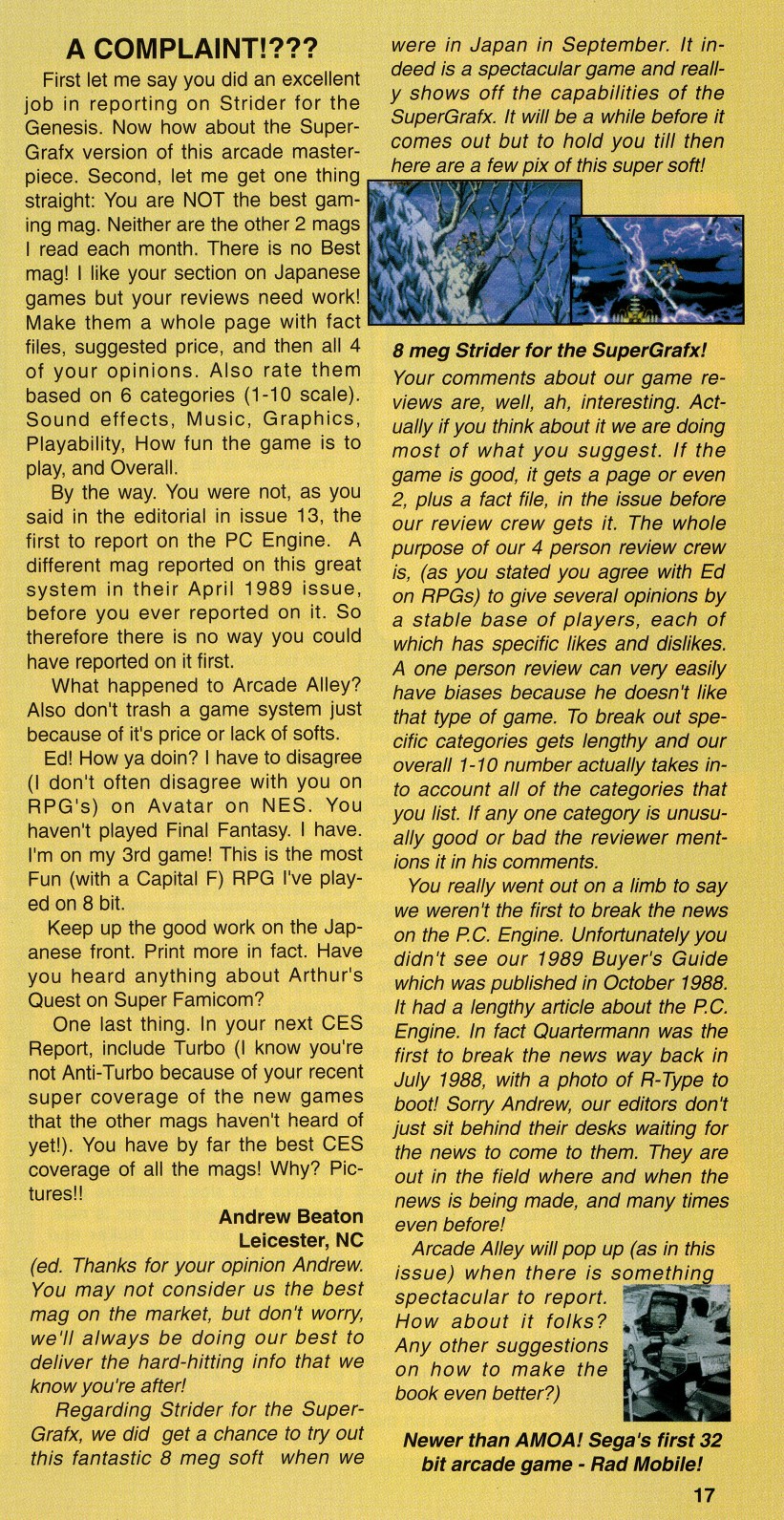 The difference between the two games' ROM sizes alone is telling. The CPS-1 ROM weighs in between 32 and 43 megabits. The ROM size for the SGX cartridge was going to be a measly 8 Mb, meaning the game was going to have to take a 75-80% reduction in image quality just to fit on the cartridge!
The difference between the two games' ROM sizes alone is telling. The CPS-1 ROM weighs in between 32 and 43 megabits. The ROM size for the SGX cartridge was going to be a measly 8 Mb, meaning the game was going to have to take a 75-80% reduction in image quality just to fit on the cartridge!
The claim that the SGX's BG2 scrolling background layer would allow accurate translation is ridiculous. CPS-1 had three scrolling layers. With a reduction in ROM size and a reduction in scrolling layers, the SGX version could not and would not have been arcade perfect. No way. Someone wasn't paying attention when they wrote that article.
Meanwhile, back in the States, someone was paying attention. Unfortunately, that person happened to be working for Electronic Gaming Monthly. In its early days, instead of actually writing their own features, EGM was notorious for stealing everything they could from the Japanese gaming mags.
Someone wrote in to the January 1991 issue of EGM and inquired about Strider for the SGX, having caught wind of the planned port. In answering his questions, EGM claimed they'd actually played the game while on a trip to Japan the previous September. Whether they actually did or not is anybody's guess. It's unlikely that the port was in any kind of playable form, having just been announced. EGM's article included two screenshots purporting to be from the SGX version, one of which would survive for years as the only tangible proof this port was ever in production. Astute readers will note, however, that these two shots were taken from PC Engine Fan #9, and EGM merely repeated what they had said.
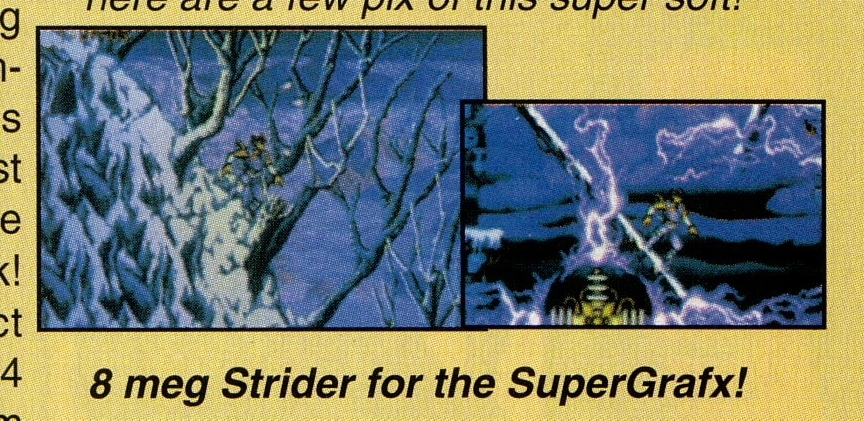
Just as EGM was passing along four-month-old news and announcing this port's release, PCE Fan was actually reporting a change in plans (also translated by Suzaku):
SG Exclusive Title Gets Canceled?
It was announced that "Strider Hiryu", which was being produced as an exclusive title for the SuperGrafx, will become a PC/SG compatible title. Good news for PC Engine users, but SuperGrafx users will probably have heart attacks. It's expected that NEC Avenue will kill their development of SG exclusives. Even so, it will continue to support the SuperGrafx as a dual-format title and will still be playable in high quality. Incidentally, "Strider Hiryu" is one of the few HuCard titles scheduled to be 8 megs.
↑ This "Strider Hiryu" screenshot is from the arcade version. It will now have dual-compatibility.
Within four months' time, the announced SGX port was demoted from a full SGX game to merely being "SGX compatible". Basically it was scheduled to be a PCE game that could be played on an SGX, similar to how PSone games can be played on a PS2.
This news also signaled the end of SGX game development. NEC Avenue, as noted before, was the only developer the SGX had. By canceling their line, they effectively killed the console, but they were trying to keep it on life support by releasing dual-format games.
Things did not look good, either for the SGX overall or Strider fans in particular. Nine months passed. Then, in September 1991, a FULL YEAR after the original announcement, PC Engine Fan ran an update (again, translation by Suzaku):
PC & SG Dual-Compatibility HuCard (Tentative)
"Strider Hiryu" is an excellent game with many fans thanks to its flashy action and tempo. The appeal of the game comes in part from the intricately animated motions of its hero, Hiryu. Though the PC Engine version is a complete port of the arcade game, the characters will be slightly smaller. There's also less flickering on the SG when compared with the PC Engine. The stage clear demos are also planned to be ported unchanged. Since the development is experiencing delays, it's expected to go on sale next year. The current development status is 20%.
↑ Hiryu faces off against a gorilla-shaped robot. This foe is like nothing you've seen before!
↑ Flashy action with Hiryu surrounded by various traps. This is the game's charm.
There's several things worth noting here. First, they actually admitted the loss in quality by converting from CPS-1 to SGX ("the characters have become somewhat smaller"). Second, the cutscenes they're talking about are not the ones from the Duo version. They're the ones we all know from the CPS-1 ("Hum, it is Strider Hiryu. He will never leave Eurasia alive."). Third, even at this date, they're saying that the game won't be out anytime soon.
How right they were. The game didn't come out in 1991. It didn't even come out in 1992, and in October of that year, EGM writer "Terry Aki" (a pseudonym if ever there was one) ran a little blurb in his "International Outlook" section, noting that Strider had once again been demoted, this time to a Super CD-ROM. Yet he still claimed it would be "greatly enhanced", once again underscoring just how out of the loop EGM really was.
I can't really blame him. Even PC Engine Fan didn't know what was going on. For example, they claimed the pictures they ran alongside their SGX articles were culled from the arcade, that is, the original CPS-1 version. But even a cursory glance shows this is not the case. Observe:
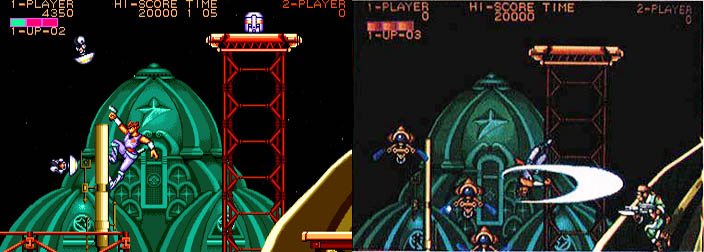
The screencap on the left is from the arcade; the one on the right is taken from the Sept. 1990 issue of PC Engine Fan. I'm sure you can tell there's more than a few differences between these two screenshots, just by glancing at them. According to Chris Covell and malducci over at the PCEngineFX forums, here's how those differences break down:
- The shot on right is missing the "starfield" background layer (BG3).
- The pole Hiryu's clinging to in the shot on left is thicker than the one from the screencap on right.
- The two shots seem to be using entirely different palettes.
- These screencaps also have two different resolutions. The resolution of the shot from the article seems to match one of the maximum resolutions of the SGX (352 pixels), while the arcade shot (left) has had to be trimmed down to match.
- There's no time elapsed in the shot on the right and its current score tally is 0, despite the player being halfway through the first level.
- Falchion's slash animation is different. It's curved more and tapers around Hiryu's body more in the shot on the right than it did in any known version.
- Hiryu's sprite in the shot on the right seems to include the protruding edge of a red sash. No existing version of Strider has a Hiryu sprite like that.
- The health meter is completely red and has a gradient on each segment in the shot on the right. Again, no existing version of Strider has this.
The amazing thing about the images from PC Engine Fan is not that they're different, but that the differences are CONSISTENT from shot to shot. Anyone can doctor a sprite. EGM's done this in many an April Fool's edition. However, I've never seen a hoax with so many screenshots that didn't mess up. Changing sprites is the obvious way to create a fake. Who would think to alter health meters and zero out high scores and make the same changes to every single shot?
Like I said earlier, someone at PC Engine Fan wasn't paying attention. They didn't know what they had on their hands. Of course, it's entirely possible that the screencaps are from a beta of the CPS-1 version, but why would PC Engine Fan run beta screencaps when the arcade down the street had working cabinets?
With even the Japanese gaming magazines getting confused, it's no wonder so many rumors popped up about this conversion. No one could get their story straight because there was no straight story to be had.
Finally, in 1994, Strider made it to the PC-Engine/TGX, in a home conversion for the Arcade Card that failed to capture gamers' interest, despite brand-new cutscenes, a new level, and an arranged soundtrack. NEC Avenue, who produced the conversion, didn't even bother to bring it stateside. That's how little confidence they had in it.
After all the hype, people wondered what happened. Why did the SGX version disappear? What about those beautiful screens seen in EGM? Did that mean someone had a working prototype? No one seemed to have any answers, and the rumor mill started to grind.
The first, and most natural rumor, was that there was a playable version floating around. This stood to reason. If NEC Avenue had actually worked on an SGX conversion, a prototype would exist.
In a 1997 post on the Turbo List, a mailing list for NEC enthusiasts, someone named Mike Lyon claimed that, all in all, NEC made five working prototypes. His post marked the first time anywhere on the Net that anyone claimed a specific number of prototypes existed. What's more, he accounted for each of them:
From: Mike Lyon <lyonx008@gold.tc.umn.edu>
Date: Sun, 05 Jan 1997 13:16:20 -0600
Subject: SG Strider: The Scoop
Here's the the scoop on Strider for the SG, for all those who are not familiar with the story.
Strider WAS programmed, up to about level 4, for the Supergrafx. It is not vaporware, as is frequently reported. Instead of using a Strider "mold" (looking at previous code and formatting it for the system), the programmers started from scratch, which was a long and costly endevour. The game was intended to surpass even the arcade version, which sounds good to me. The Supergrafx was more than capable of it.
When the project was scrapped, due to the massive NES/PCE war that I will not get into, there were FIVE WORKING E-proms. Not cards. E-proms. That's prototypes for all of you not in the know. They're big, ugly, and look nothing like Hu-cards. I do not wish to discount [some random poster], but just how his friend got a hold of this is f***ing beyond me. Take these factors into account:
Copy #1 went to the Hudson vaults. There it will remain until Hudson goes out of business, at which point it will become part of the Hudson estate or be turned over to a company that might buy them out.
Copy #2 went to the head programmer of Strider. I believe he lives in Kobe. Good luck in finding him.
Copy #3 was given to the original designer of Strider, who had a close interest in the development of the SG version. After the failure of the SG, he wasn't present for the ACD development, which could account for it's poor quality.
Copy #4 was the press copy; this is the copy that Gamefan and EGM and all those mags had the Strider pictures in. The press E-prom contained only the first level of the game and a credit sequence, if I'm correct. The press copy, to the best of my knowledge, no longer exists.
Which leaves copy #5 and copy #5 ALONE unaccounted for. Maybe [previously mentioned poster]'s friend is the lucky guy who owns THIS TRULY ONE OF A KIND ITEM, but I HIGHLY DOUBT IT.
If [previously mentioned poster]'s pal does have the 5th copy, he'd better cough up some Polaroids real quick, or there are going to be many skeptical and angry turbo fans on this list!
Lyon!
All rumors concerning the number of betas or alphas or prototypes for the SGX Strider conversion trace to the above post. Even Daniel Riley's assertion that there were four copies of a three-level playable alpha in existence trace back to this post. If it's correct, then one EPROM went to Hudson, because they were the first-party developer for the TGX and SGX. They owned a huge share of NEC. Strider's lead programmer was Isuke, so that's where another went; and a third went to either Moto Kikaku or Tatsumi Wada, the "original creator[s] of Strider". The fourth, the press copy, may still be around but is most likely in a landfill. It was complete at least through level two, as the screencaps from PCE Fan prove.
That left one EPROM remaining, according to this post. But is this account trustworthy? Mike Lyon stated that the ROM had been completed through level 4, the Amazon stage. That's about 80% complete. This is curious, because the Sept. 1991 PC Engine Fan indicated the game only reached 20% completion. It could have been developed further, as another year elapsed between when it was demoted to the bi-compatible format and it being demoted yet again to the Arcade Card. Still, 80% completion seems to be pushing it.
Lyon also says the SGX was "more than capable" of beating the CPS-1. That couldn't possibly happen.
Then he talks about the EPROMs. EPROMs do indeed look nothing like HuCards or CD-ROMs, however, it's possible to dump an EPROM onto a HuCard. That's how the HuCard manufacturing process worked, in fact. If there were five EPROMs around, it's possible, if unlikely, that someone dumped one to a HuCard. Ultimately, Lyon's post (and all subsequent Strider SGX prototype rumors, for that matter) should be taken with a grain of salt. The never-substantiated tale of five EPROMs has taken on mythic proportions and turned into a self-perpetuating myth that continues to this day.

Another slightly more sinister urban legend that persists to this day is the rumor that one of the programmers working on the SGX version committed suicide. The story goes that this unfortunate soul was put under intense pressure to deliver a superior port. As Mike Lyon noted above, the SGX conversion required all-new source code, unlike the MegaDrive/Genesis conversion, which was compatible with the CPS-1. Trying to live up to the hefty promises made on behalf of the SGX conversion caused this young man to crack, and he was committed and eventually killed himself. As an homage to this programmer, when Capcom included Hiryu's cameo on Ken's stage in Street Fighter Alpha 2, they also included a teddy bear. Presumably the teddy bear represented the programmer's regression.
This rumor originally surfaced as a factoid on Videogames.com's 1997 article series "The History of Street Fighter", where it read as follows:
Street Fighter Trivia
Rumor out of Capcom had it that Strider's inclusion in Ken's background was a tribute to a former Capcom employee who had been involved in working on a conversion of Strider for NEC's ill-fated SuperGrafx console. The story has it that NEC placed heavy pressure on the Strider team to cram more detail into the SuperGrafx conversion than had been fit on the 8-megabit Sega Genesis cartridge, and that the Capcom employee cracked under the stress and wound up in a mental hospital. Strider's SFA2 teddy bear was supposedly a reference to the employee's intractable condition. Strider was cancelled for the SuperGrafx and an unimpressive port was released years later for the PC Engine.
From there, it spread to Ralph's Mysterious Video Game Deaths page, where it took on a new iteration under the heading, "That Guy Who Killed Himself Over Strider":
Although prototypes are rumored to exist, SuperGrafx Strider never saw the light of day. Eventually a port to NEC's PC Engine Arcade Card was released in the mid '90s, but it paled in comparison to even Sega's flawed release. It is this failure to surpass even the Genesis/Megadrive's level of quality that apparently drove one of its programmers to suicide. Although this is a completely unsubstantiated rumor, I have heard from very trustworthy sources that one of the programmers took his own life in a bout of depression allegedly caused by the poor quality of the game.
The suicide rumors started there. Ralph had at least admitted that the story was "completely unsubstantiated rumor", but that didn't prevent the tale from spreading like wildfire.

Not to be insensitive to the programmer's family if this story is true, but I've never believed anyone committed suicide over the SGX version, simply because there's a teddy bear in the CPS-1 game itself. It's a bonus item you can obtain in Level 3, the Flying Battleship Ballog. Here's how to find it: once you've passed the turrets and the railgun in the opening sequence, get to the floor. You have a choice to either go down and crawl along the outside of the battleship, or continue on inside. Behind you should be three levels of platforms, covered in shells. Destroy the shells. Get to the top platform. The teddy bear will pop out of a porthole and laugh at you. How could a teddy bear that's an homage to the programmer's mental breakdown appear in a game that was released before the supposed breakdown occurred?
Now, this doesn't necessarily disprove the programmer's breakdown, but it does render the teddy bear rumor highly suspect.
This psychologically destabilized programmer was never named. I used to think it was Isuke, and I based my opinion on three pieces of evidence. The first was a snippet of insertcredit.com's interview with Roy Ozaki of Mitchell Corp back in January of 2006. Ozaki had this to say concerning Strider and Isuke in particular:
CHZ: One memorable aspect of Cannon Dancer is its similarity to Capcom's Strider Hiryu. Strider Hiryu and Cannon Dancer had the same game designer, Isuke. Were other ex-people from Capcom working on the game?
OZA: You know that game people move around. We had some Capcom misfits in the past.
My second piece of evidence came from Darran Jones, publisher of Retro Gamer magazine and avid Strider fan. In 2007, when asked why his magazine had yet to do an issue about Strider, Darran answered,
Believe it or not, I actually have a contact with Isuke (the guy who created Strider) but he's very reluctant to talk.
Which in a way is probably a good thing, because once I have a making of that bad boy my work on RG will be done and I can embrace new technology again.
Two years later, Darran Jones' clarified his remarks about Isuke:
Honour is [...] a difficult obstacle to overcome. I've known where the creator of the Strider arcade game has been for years, but he will not speak to me unless I get permission from Capcom Japan. So far that permission hasn't been forthcoming so he won't speak to me :(
Taken together, these statements seemed to imply that Isuke is difficult to work with. If Isuke and the mysterious programmer who had a breakdown are one and the same, it would explain a lot. Isuke was difficult to work with during his tenure at Mitchell Corp because he was recovering from a total breakdown. He would be reluctant to talk about Strider because that would be an embarrassing period of his life. And of course, the fact that Isuke's still very much alive would decisively put an end to the rumor that someone killed themselves during the development of the SGX port.
This turned out to be entirely wrong. In a 2010 interview with the LSCM, Strider coin-op planner Kouichi Yotsui said this on the matter:
There's many difficulties one must face when making a game. When I was younger, I indeed felt like I shaved a bit of my life off each time I made a game. But, that's simply an illusion due to lack of experience. As I leveled myself up, I was able to create games with time to spare. I, too, have heard many rumors about people going crazy and even killing themselves during development. It sounds like a viable option. However, whether or not I think it's actually happened, I would have to say only an amazingly small part of me thinks so.
I think Strider throwing teddy bears was simply the SF0 staff innocently goofing off. The graphic staff and planners will sometimes conspire against the planner and put something in without his knowledge. For Strider, someone put a panda in the battleship's cannon room without my knowing. The person who did that later became [Keiji Inafune]'s wife, fully supporting her husband's success.
If someone did go nuts or kill themselves, it wasn't Isuke. It also wasn't Mrs. Keiji Inafune, who started the teddy bear cameo. Masahiko Kurokawa, who planned the Famicom/NES port, was alive long enough to work on both the first Resident Evil game and Final Fantasy: The Spirits Within, so it wasn't him either. Tatsumi Wada went on to produce the Ikegami Brothers manga for Daisanbunmeisha after Moto Kikaku's collaboration with Capcom. None of these people were connected to the SuperGrafx port.
However, there is another possibility. Kevin Gifford, a former professional game journalist who has worked for GamePro and 1up.com, runs a behind-the-scenes gaming blog called Magweasel. In a July 2009 post about the PC Engine port of Fantasy Zone, Gifford made the following offhand comment suggesting a completely different take on the suicide rumor:
During the Avenue era, much of NEC’s internal software development was led by a man named Toshio Tabeta, a name infamous among PCE fans. He’s a talented man, and he produced some great stuff, but his reputation for perfectionism [...] led to his titles getting delayed, and delayed, and delayed, sometimes into oblivion. [...] Strider [was] originally announced as a HuCard but then bounc[ed] through every possible PCE format there is before finally coming out as an Arcade Card-exclusive title in 1994. Not once, but twice, he made promises to magazines that “if my game’s delayed any longer, I’ll shave my head” — and then performed the act right in front of their cameras a few months later.
Gifford also remarked that Toshio Tabeta is now president of Japanese gaming company Prototype, Inc. So he's not dead either, nor did he lose his mind. Just his hair.
Regardless of whether or not someone killed themselves, the SGX port was never released. It did exist at one point in a developmental stage, but whether it still does is something only those at Moto Kikaku, Capcom, Hudson, or possibly Prototype would know. It may surface one day, but unless that happens it will continue to be consigned to urban legend status.
Don't give up hope in the meantime, though. ;^)
In closing, I'd like to thank Chris Covell and malducci for their stellar research into the PC Engine Fan articles that convinced me they were the real deal; Suzaku, for translating them; Lawrence Wright of NFG Games, for pointing out the flaws in Mike Lyon's Turbo List post and just generally being a good sport; Parallax Scroll for sending me the scans of EGM 18's article; and everyone who's cited this page as a source over the years. You all have my gratitude.
Sources
- Wright, Lawrence. "101* Secrets of the PC Engine (*Or Maybe Less)". NFG Games.
- Varley, Michael. "History". Strider-Otaku. 21 Jan 2001.
- Covell, Chris. "The PC-Engine Unrelease List". ChrisCovell's Homepage.
- Covell, Chris. "Strider...". p. 3, #30. PCEngineFX.com Forums. 2 Feb 2007.
- malducci. "American hype for SuperGrafx Strider started here in EGM!". p. 2, #18. PCEngineFX.com Forums. 13 Mar 2006.
- Lyon, Mike. "SG Strider: The Scoop". Turbo List Digest. 05 Jan 1997.
- Riley, Daniel. "Strider". SuperGrafx Extreme.
- "The History of Street Fighter: The Games: Street Fighter Alpha 2". p. 2. Videogames.com. 1997.
- Ralph. "Ralph's Mysterious Video Games Page: That Guy Who Killed Himself Over Strider". RalphSpace.
- Seydoux, Chaz. "shokkingu hitofude". Insert Credit. 16 Jan 2006.
- Jones, Darran. "Retro Gamer Issue 34". p. 1, #9. rllmukforum.com. 24 Jan 2007.
- Jones, Darran. "Coin Op Capers". p. 1, #12. Retro Gamer forum. 2 Sep 2009.
- Yotsui, Kouichi. "Interview with Kouichi 'Isuke' Yotsui". Light Sword Cypher Mainframe. 24 Apr 2010.
- Gifford, Kevin. "[I ♥ The PC Engine] Fantasy Zone". Magweasel. 14 Jul 2009.
